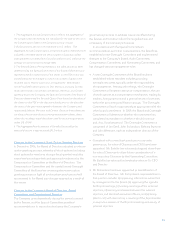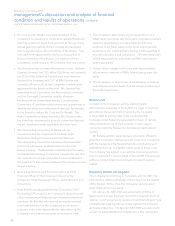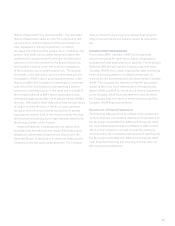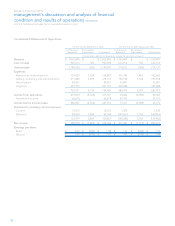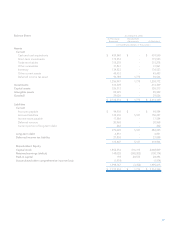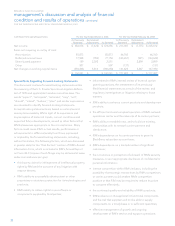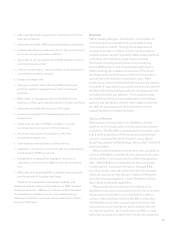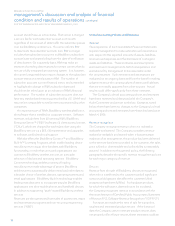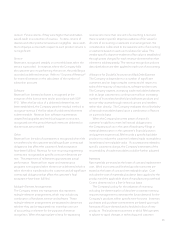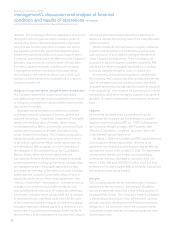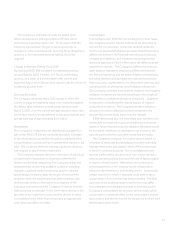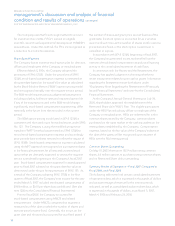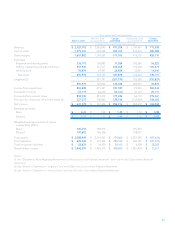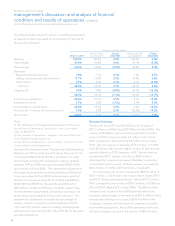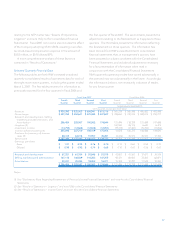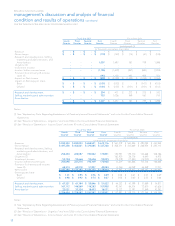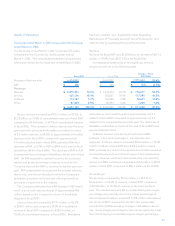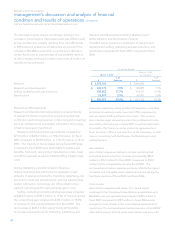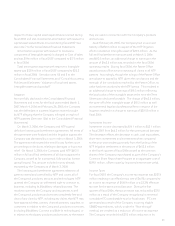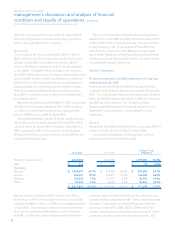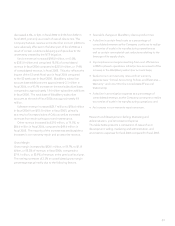Blackberry 2007 Annual Report Download - page 35
Download and view the complete annual report
Please find page 35 of the 2007 Blackberry annual report below. You can navigate through the pages in the report by either clicking on the pages listed below, or by using the keyword search tool below to find specific information within the annual report.33
The Company’s estimates of costs are based upon
historical experience and expectations of future return
rates and unit warranty repair cost. To the extent that the
Company experiences changes in warranty activity, or
changes to costs associated with servicing those obligations,
revisions to the estimated warranty liability would be
required.
Change in Estimate During Fiscal 2007
During fiscal 2007, RIM increased its estimated warranty
accrued liability by $3.1 million, or 0.1% of consolidated
revenue, as a result of a net increase in the current and
expected future return (for warranty repair) rates for certain of
its devices product lines.
Earnings Sensitivity
The Company estimates that a 10% change to either the
current average unit warranty repair cost, measured against
the device sales volumes currently under warranty as at
March 3, 2007, or to the current average warranty return rate,
would have resulted in adjustments to warranty expense and
pre-tax earnings of approximately $3.6 million.
Investments
The Company’s investments are classified as available-for-
sale under SFAS 115 and are carried at fair value. Changes
in fair values are accounted for through accumulated other
comprehensive income, until such investments mature or are
sold. The Company does not exercise significant influence
with respect to any of these investments.
The Company assesses declines in the value of individual
investments for impairment to determine whether the
decline is other-than-temporary. The Company makes this
assessment by considering available evidence, including
changes in general market conditions, specific industry
and individual company data, the length of time and the
extent to which the market value has been less than cost,
the financial condition, the near-term prospects of the
individual investment and the Company’s intent to hold the
debt securities to maturity. In the event that a decline in the
fair value of an investment occurs and the decline in value
is considered to be other–than-temporary, an appropriate
write-down would be recorded.
Income taxes
In accordance with SFAS 109, Accounting for Income Taxes,
the Company uses the liability method of tax allocation to
account for income taxes. Under this method, deferred
income tax assets and liabilities are determined based upon
differences between the financial reporting and tax bases
of assets and liabilities, and measured using enacted tax
rates and laws that will be in effect when the differences are
expected to reverse. The Company’s deferred income tax
asset balance represents temporary differences between
the financial reporting and tax basis of assets and liabilities,
including research and development costs and incentives,
financing costs, capital assets, non-deductible reserves, and
operating loss carryforwards, net of valuation allowances.
The Company considers both positive evidence and negative
evidence, to determine whether, based upon the weight of
that evidence, a valuation allowance is required. Judgment
is required in considering the relative impact of negative
and positive evidence. The Company records a valuation
allowance to reduce deferred income tax assets to the
amount that is more likely than not to be realized.
If RIM determines that it is more likely than not that it will
not be able to realize all or part of its deferred income tax
assets in future fiscal periods, the valuation allowance would
be increased, resulting in a decrease to net income in the
reporting periods when such determinations are made.
The Company’s provision for income taxes is based on
a number of estimates and assumptions as determined by
management and is calculated in each of the jurisdictions
in which it conducts business. The consolidated income
tax rate is affected by the amount of net income earned in
various operating jurisdictions and the rate of taxes payable
in respect of that income. RIM enters into transactions
and arrangements in the ordinary course of business in
which the tax treatment is not entirely certain. In particular,
certain countries in which it operates could seek to tax a
greater share of income than has been provided. The final
outcome of any audits by taxation authorities may differ
from estimates and assumptions used in determining the
Company’s consolidated tax provision and accruals, which
could result in a material effect on the consolidated income
tax provision and the net income for the period in which such
determinations are made.


